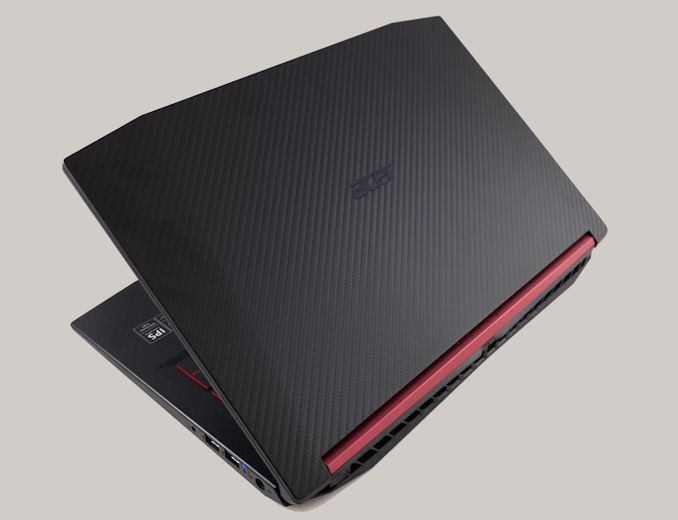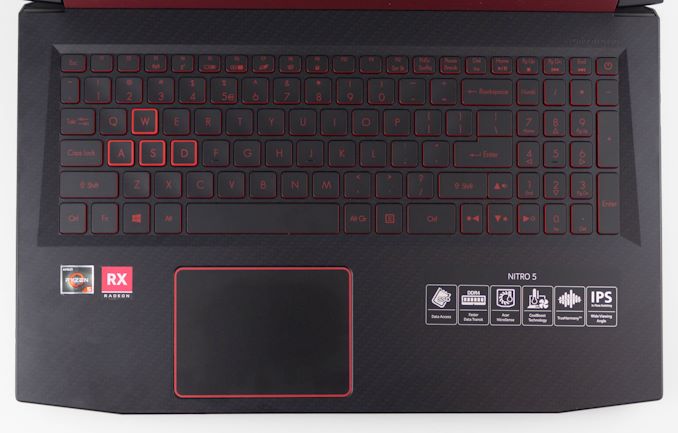The Acer Nitro 5 Gaming Laptop Review: Absolutely AMD - Ryzen Plus Polaris
by Brett Howse on February 15, 2019 8:30 AM ESTDesign
Gaming laptops generally fall into two categories based on their size, which is usually 15.6 and 17.3 inches. The larger laptops offer more space for extra cooling, but they can be so large that its difficult to move them around. The Acer Nitro 5, at 15.6-inches, is surprisingly svelte (especially for the price), but even then it is still 1.1-inches thick and weighs just under 6 lbs.
One of the easiest ways to save some cost is on the chassis, and the Acer Nitro 5 is made completely out of plastic. What the company has done to improve the look and feel though is to incorporate a faux carbon fibre weave into the design, which covers the top of the laptop, as well as the keyboard deck. It provides some much-needed texture on the top of the laptop, and provides a nice look and feel to the device without being too over-the-top. For contrast, there’s a red hinge bar, and the keyboard backlighting is red as well. Due to the budget nature, there’s also no thin-bezel design that we’ve seen on even some gaming laptops, so this is a large and wide laptop for 15.6-inches of screen space.
The large size does allow Acer to cram in a full keyboard with number pad on the right. 15.6-inch devices with a number pad are kind of a mixed bag though, since the keys tend to get pretty crammed together, and this model is no exception. The lack of a full size zero key also makes transitioning to this number pad less than ideal, but it is there if you need it. The other tradeoff is that it pushes the rest of the keyboard off center. Acer also commits a faux pas by putting the power button in the keyboard, which means you may accidentally turn off the computer while typing, although this is mitigated by it being above the number pad and not near the keys you’d use most of the time.
As for key feel, this is another area where Acer has saved some room on the bill of materials. The keyboard doesn’t offer very much travel, and the keys are quite slippery and don’t offer much tactile response either. With gaming laptops offering quite a bit more Z height than something like an Ultrabook, it would be nice to see a keyboard with a bit more travel here.
Luckily the same can’t be said of the trackpad, which is a generous size without being unwieldly, and the trackpad offers an incredibly smooth surface, and detects taps, two-finger scrolling, and more, with zero issues. Considering the sad state of trackpads on many laptops, this was unexpected considering the value segment Acer is targeting.
Acer offers two USB 2.0 ports on the right side, coupled with the barrel power connector and headset jack, and the left side offers a Type-C USB 3.1 Gen1 port, along with a USB 3.0 Type-A, HDMI, and an SD card reader. The RJ45 connector has a hinged section on the bottom to allow it to expand to full size when a network cable is plugged in. It can be a bit of a struggle to get the connector back out again though, but if you’re using the laptop on a desk, it’s still worth having the Gigabit connection.
Overall the design is very nice. The low-end material for the chassis is spruced up with the carbon-fibre look, and the chassis itself doesn’t flex or bend at all if you pick it up on one size. The Acer Nitro 5 doesn’t offer the premium look and feel of some of the top gaming systems, but it also doesn’t come with their price tag.














90 Comments
View All Comments
RSAUser - Friday, February 15, 2019 - link
Did you try and use the wattman auto undervolt for the graphics card?Does Radeon Chill work for mobile? Then fan noise should go down and battery should last longer.
Testing max fps is bad, don't even have minimum fps, let alone frame time plots to know how smooth it is.
jgraham11 - Friday, February 15, 2019 - link
Wow, did anyone notice that all the other processors are 45Watt meanwhile the AMD chip is only 15W!!! Holy crap!PeachNCream - Friday, February 15, 2019 - link
How can you miss that fact? The differences in TDP were pointed out multiple times in the article. You'd have to be in some serious skim mode to overlook it.cfenton - Saturday, February 16, 2019 - link
From the article: "Being a U series, the TDP is 15-Watts by default, though AMD offers a range of cTDP modes from 12-25 Watts. This is a rarely tapped feature on most laptops, but in this case it looks like Acer has put the Ryzen in cTDP up mode."So the AMD chip is 25w and the Intels are using 35w. It's a difference for sure, but it's not 15w vs 45w.
Brett Howse - Saturday, February 16, 2019 - link
The Intel ones are 45W - the 35W is an optional cTDP down mode.cfenton - Saturday, February 16, 2019 - link
My mistake. Thanks for the clarification.jgraham11 - Saturday, February 16, 2019 - link
For sure I believe you are correct, except for the MSI one which is 45watt.One thing I did find while looking at these specs for these Laptops:
Note all Newegg.com prices except the Acer AMD setup, as I could not find it. Prices are as of Feb 16 2019.
MSI GT75 TITAN GTX 1080 8 GB VRAM i9-8950HK sells for $4958.64
Huawei MateBook X Pro Intel Core i7 8th Gen 8550U MX150 sells for $1449.00
Dell XPS 15 core I7-7700HQ GTX 1050 sells for $1849.55
Microsoft Surface Book 2 Core i7 8650U GTX 1050 sells for $2279.00
This is not an Apples to Apples comparison in the least!
Meanwhile they are comparing it to a $699 AMD laptop....
Do you think that the extra $1k would provide a metal chassis which would result in better overall thermals hence better performance. And a better screen...
Anandtech please compare this one to another Acer Nitro 5 but with an Intel processor to actually make it a fair comparison.
Brett Howse - Saturday, February 16, 2019 - link
I explained why the comparison models were chosen in the review.fmcjw - Sunday, February 17, 2019 - link
Really? You don't take suggestions really well do you? I second jgraham11's suggestion because the thermal design makes each Intel Core a different beast.This is really an amateurish review, you can get as much info from a compact notebookcheck.com analysis. Who needs to be told that "Being a SATA based SSD, peak performance is certainly limited compared to NVMe drives, but it still offers orders of magnitude better performance compared to spinning drives?" Just show it in a table or chart. Are you being paid to hit a certain word count?
And you're unclear on whether adding a second RAM makes it dual channel, nor have you mentioned that you tried to see if Dual Channel is supported, but rather stuck to whatever configuration the company sent you.
Calin - Monday, February 18, 2019 - link
For spinning versus solid state hard drive performance, you have plenty of comparisons - when the transition took place, 5 or so years ago. Today's SATA SSD's aren't so much faster than the champions of 5 years ago (in typical end-user scenarios), but neither have the magnetic hard drive performance improved.